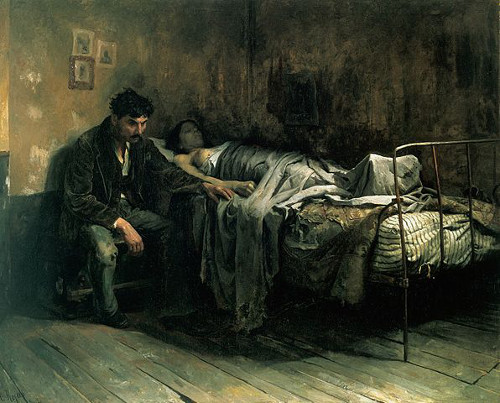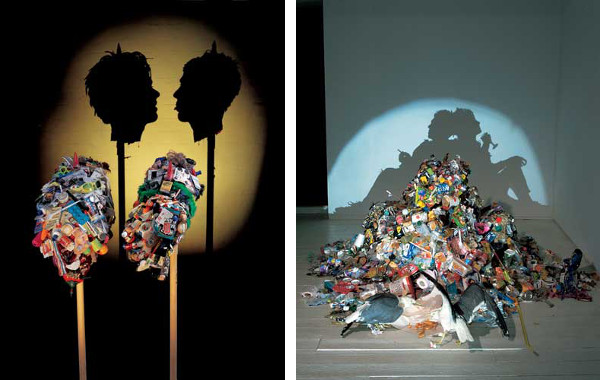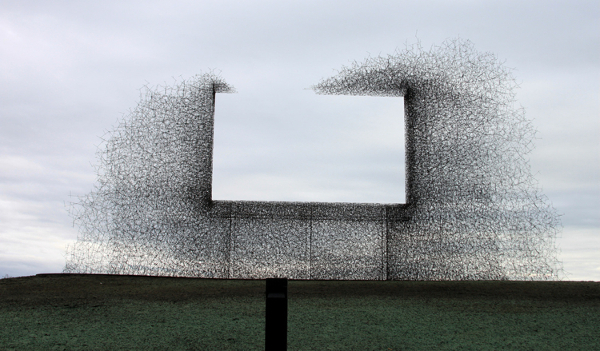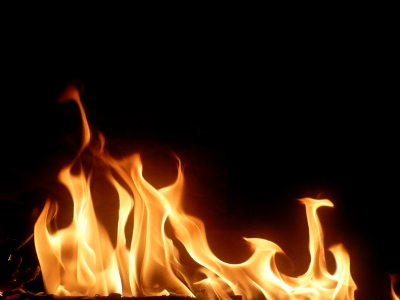
obolary
adj. poor or impecunious
inopious
adj. lacking wealth or resources; needy
ptochocracy
n. government by the poor

obolary
adj. poor or impecunious
inopious
adj. lacking wealth or resources; needy
ptochocracy
n. government by the poor

Artists Tim Noble and Sue Webster find self-portraits in arrangements of domestic trash. Their Dirty White Trash (with Gulls) (1998, right) was contrived from the six months’ rubbish they produced while making it, a sculpture produced by the residue of its own composition.
More shadow art: Shigeo Fukuda, Larry Kagan, Richard Haas.

Somewhat related: Last year travelers from Washington state to Vancouver were surprised to discover this “negative space” billboard by the side of the road. It was created by Daniel Mihalyo and Annie Han of Seattle-based art collective Lead Pencil Studio. Most billboards draw the eye away from the environment; this draws the eye to it.
(Thanks, Alex and Bob.)

A puzzle by Pierre Berloquin:
In my house are a number of rooms. (A hall separated from the rest of the house by one or more doors counts as a room.) Each room has an even number of doors, including doors that lead outside. Is the total number of outside doors even or odd?

The goal of the Shakespeare programming language is to create code that reads like a Shakespearean play: Variables are “characters” that interact through dialogue, constants are represented by nouns and adjectives, and if/then statements are phrased as questions. (Insulting Macbeth assigns him a negative value.) Act and scene numbers serve as GOTO labels, and characters can tell one another to “remember” or “recall” values. The phrases “Open your heart” and “Speak your mind” output a variable’s numerical value and the corresponding ASCII character, respectively.
This program prints the phrase HELLO WORLD:
Romeo, a young man with a remarkable patience.
Juliet, a likewise young woman of remarkable grace.
Ophelia, a remarkable woman much in dispute with Hamlet.
Hamlet, the flatterer of Andersen Insulting A/S.
Act I: Hamlet's insults and flattery.
Scene I: The insulting of Romeo.
[Enter Hamlet and Romeo]
Hamlet:
You lying stupid fatherless big smelly half-witted coward! You are as
stupid as the difference between a handsome rich brave hero and thyself!
Speak your mind!
You are as brave as the sum of your fat little stuffed misused dusty
old rotten codpiece and a beautiful fair warm peaceful sunny summer's
day. You are as healthy as the difference between the sum of the
sweetest reddest rose and my father and yourself! Speak your mind!
You are as cowardly as the sum of yourself and the difference
between a big mighty proud kingdom and a horse. Speak your mind.
Speak your mind!
[Exit Romeo]
Scene II: The praising of Juliet.
[Enter Juliet]
Hamlet:
Thou art as sweet as the sum of the sum of Romeo and his horse and his
black cat! Speak thy mind!
[Exit Juliet]
Scene III: The praising of Ophelia.
[Enter Ophelia]
Hamlet:
Thou art as lovely as the product of a large rural town and my amazing
bottomless embroidered purse. Speak thy mind!
Thou art as loving as the product of the bluest clearest sweetest sky
and the sum of a squirrel and a white horse. Thou art as beautiful as
the difference between Juliet and thyself. Speak thy mind!
[Exeunt Ophelia and Hamlet]
Act II: Behind Hamlet's back.
Scene I: Romeo and Juliet's conversation.
[Enter Romeo and Juliet]
Romeo:
Speak your mind. You are as worried as the sum of yourself and the
difference between my small smooth hamster and my nose. Speak your
mind!
Juliet:
Speak YOUR mind! You are as bad as Hamlet! You are as small as the
difference between the square of the difference between my little pony
and your big hairy hound and the cube of your sorry little
codpiece. Speak your mind!
[Exit Romeo]
Scene II: Juliet and Ophelia's conversation.
[Enter Ophelia]
Juliet:
Thou art as good as the quotient between Romeo and the sum of a small
furry animal and a leech. Speak your mind!
Ophelia:
Thou art as disgusting as the quotient between Romeo and twice the
difference between a mistletoe and an oozing infected blister! Speak
your mind!
[Exeunt]
Because it’s written as a play, a program can be performed by human actors, but the drama lacks a certain narrative drive:
See Output.

“It has been said of the Iliad that anyone who starts reading it as history will find that it is full of fiction but, equally, anyone who starts reading it as fiction will find that it is full of history.” — Arnold Toynbee
B.S. Johnson’s 1969 “book in a box” The Unfortunates consists of 27 unbound sections, ranging in length from a single paragraph to 12 pages. The first and last chapters are specified, but the 25 in between can be read in any order. Johnson felt this was a “better solution to the problem of conveying the mind’s randomness than the imposed order of a bound book.”
Jerzy Andrzejewski’s 40,000-word novel The Gates of Paradise, published in 1960, consists of only two sentences. The second is “And they marched all night.”
When Edgar Wallace published his detective thriller The Four Just Men in 1905, he challenged readers of the Daily Mail to guess the murder method, offering first, second, and third prizes of £250, £200, and £50. Unfortunately he failed to specify that each prize would go to a single entrant, so he was legally obliged to award a prize to every correct entry. He went bankrupt, and the newspaper had to pay more than £5,000 to protect its reputation.
From Lancelot Hogben’s Mathematics in the Making, an appealingly memorizable table of basic trigonometric values:

See Alison’s Triangle.
(Thanks, Tom.)
A great deal of the work of the post office would then be to regulate the use of these personal television channels. Much of the information now sent by mail could be sent through the air on the personal channel, to be viewed in the home or to be printed out for a more or less permanent record. …
Very likely there will be a signal light to indicate that a message is waiting to be viewed. When the personal channel is then activated, each item stored will be displayed in turn. Each can be scanned and erased, scanned and temporarily returned to storage, or scanned and printed out, after which the next item would appear. It will be very much like going through one’s mail today, with its mixture of personal items and advertising, in which some are discarded, some put aside, and some filed.
— Isaac Asimov, “The Individualism to Come,” New York Times, Jan. 7, 1973
The sum of the proper divisors of 14316 is 19116.
The sum of the proper divisors of 19116 is 31704.
The sum of the proper divisors of 31704 is 47616.
The sum of the proper divisors of 47616 is 83328.
The sum of the proper divisors of 83328 is 177792.
The sum of the proper divisors of 177792 is 295488.
The sum of the proper divisors of 295488 is 629072.
The sum of the proper divisors of 629072 is 589786.
The sum of the proper divisors of 589786 is 294896.
The sum of the proper divisors of 294896 is 358336.
The sum of the proper divisors of 358336 is 418904.
The sum of the proper divisors of 418904 is 366556.
The sum of the proper divisors of 366556 is 274924.
The sum of the proper divisors of 274924 is 275444.
The sum of the proper divisors of 275444 is 243760.
The sum of the proper divisors of 243760 is 376736.
The sum of the proper divisors of 376736 is 381028.
The sum of the proper divisors of 381028 is 285778.
The sum of the proper divisors of 285778 is 152990.
The sum of the proper divisors of 152990 is 122410.
The sum of the proper divisors of 122410 is 97946.
The sum of the proper divisors of 97946 is 48976.
The sum of the proper divisors of 48976 is 45946.
The sum of the proper divisors of 45946 is 22976.
The sum of the proper divisors of 22976 is 22744.
The sum of the proper divisors of 22744 is 19916.
The sum of the proper divisors of 19916 is 17716.
The sum of the proper divisors of 17716 is 14316 again.

Shortly after his travel book Alexandria appeared in December 1922, E.M. Forster received a regretful letter from the publisher, Whitehead Morris & Co. There had been a fire in the warehouse and the entire edition had been burned. Fortunately, it had been insured, and they enclosed a substantial check in compensation.
“A few weeks later Forster received a yet more regretful letter from the publishers,” notes editor Lawrence Durrell in the book’s 1961 edition. “The books had been found intact, in a cellar which had escaped the flames. This, in view of the insurance money, his publishers wrote, had created a most awkward situation, and they had taken the only way out: they burnt the books deliberately.”